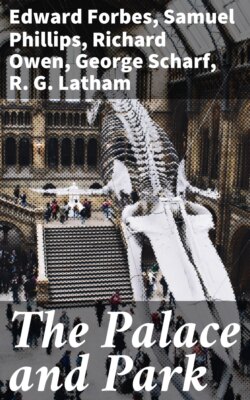Читать книгу The Palace and Park - Edward Winslow Forbes - Страница 16
На сайте Литреса книга снята с продажи.
THE ELIZABETHAN COURT.
ОглавлениеThe architectural details in this Court are taken from Holland House, at Kensington, a fine old mansion made interesting to us by many associations. Elizabethan architecture, which was in its flower during the latter half of the 16th century—more than a hundred years after the revival of classical architecture in Italy—shows the first symptoms of the adoption of the new style in England. The Elizabethan style—the name reaches back over the century—is characterised by much-pierced stonework, rectangular ornamentation, and a rough imitation of antique detail applied to masses of building, in which many Gothic features were still retained as regards general form, but altered as to ornament. The style being in its very nature transitory, it gradually gave way, although characterised by a certain palatial grandeur and striking picturesqueness, before the increasing knowledge which England obtained of Italian architecture, until we find it entirely displaced in the first half of the 17th century by the excellent style of building introduced by Inigo Jones. We must add, that, although it has no pretensions to the character of a regular or complete system, yet few who have visited the great Elizabethan mansions scattered over England can have failed to admire their picturesque and solid appearance, their stately halls, corridors, staircases, and chimney-pieces, and the beautiful garden terraces, which form so important a feature in their general design.
Façade from Elizabethan Court.
The kneeling effigies in the gallery at the back of this court are from the Hertford monument in Salisbury Cathedral, and represent the sons of the Countess of Norfolk, who lay on either side of her. The Court contains several tombs of the period. The first is that of Sir John Cheney, from Salisbury Cathedral: a soldier who distinguished himself in the wars of the Roses, and was attached to the party of Henry VII. The original effigy is in alabaster, a material much used during the early part of the 16th century. The next monument is that of Mary Queen of Scots from Westminster Abbey, executed in the beginning of the 17th century, and displaying in its treatment all the characteristics of the Elizabethan style. Under the arch in the centre is the bust of Shakspeare, from his monument in Stratford-on-Avon Church. The succeeding monument is that of Queen Elizabeth, also from Westminster, constructed at about the same period as that of Queen Mary; the original effigy is of white marble. The last monument is that of Margaret, Countess of Richmond and Derby (the mother of Henry VII.), at Westminster. It is the work of the Florentine sculptor Torrigiano; the original is in copper, and its date the early part of the 16th century; it is of unusual merit. Advancing a few paces, the visitor again reaches the Nave, and turning still southward, finds himself before
